Chinese Name: 中山公园 Pronunciation: zhōngshān gōngyuán
Recommended Visiting Hours: 1-2 Hours
Occupied Area: 238,000 square meters
Best Visiting Season: Autumn (June to August)
Address: No.4 Zhonghua Road, Dongcheng District, Beijing, China
| Attractions | Standard Price | Half Price |
| Joint Price | 3 yuan | 1.5 yuan |
| Tanghuawu and Huifang Garden | 5 yuan | 2.5 yuan |
| Spring flower and Tulip flower show period (From early March to mid-May each year) | 10 yuan | 5 yuan |
1. Children aged between six and eight enjoy half price.
2. Children aged under six or shorter than 1.2 meters, seniors over 60, and visitors with disabilities are free of charge.
| Date | Ticket Office Opening Hours | Closing Time |
| April 1st to May 31st | 6:00-20:00 | 21:00 |
| June 1st to August 31st | 6:00-21:00 | 22:00 |
| Nine 1st to October 31st | 6:00-20:00 | 21:00 |
| November 1st to March 31st | 6:30-19:00 | 20:00 |
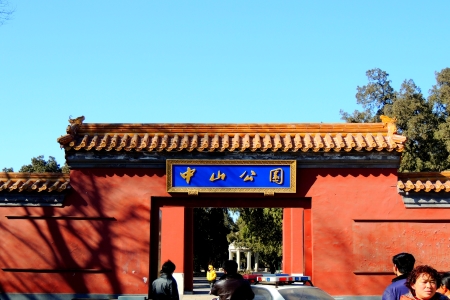
Located on the West Side of Tian’anmen Square, Zhongshan Park is a 23.8-hectare temple garden near the Jinshui Bridge, the Forbidden City and Zhongnanhai. In 1988, Zhongshan Park was listed as one of the nation’s key cultural relics protection units. The site of the park was originally an ancient temple in the Tang Dynasty (618-907), and then it was the Wanshou Xingguo Temple in the Yuan Dynasty (1271-1368). The Altar of Land and Grain in the park symbolizes the imperial power of the king and the country’s harvest and is the place where the feudal emperors offered sacrifices to the Earth God. In addition, the park also has Five-color Soil Altar, Sacred Kitchen and Storeroom, Zaisheng Pavilion and other ancient sacrificial buildings.
Zhongshan Park, originally called Central Park, is the first public park in Beijing, and because of its superior location and beautiful scenery, it has become one of the most popular tourist attractions in the capital. It is a gathering place for people from all walks of life and social groups, and even celebrities. For example, Li Dazhao, Ba Jin and Lu Xun gathered here for tea. In 1925, when Mr. Sun Yat-sen died, the park was officially changed to Zhongshan Park in honor of him. After that, Waterside Pavilion, Maxim Pavilion and Tanghuawu, and other facilities were built in the park. After the founding the People’s Republic of China in 1949, the park also built Yu Garden and other scenic spots. In 2000, it was named the Capital Civilization Unit. In 2002, it was named the first batch of boutique parks in Beijing.
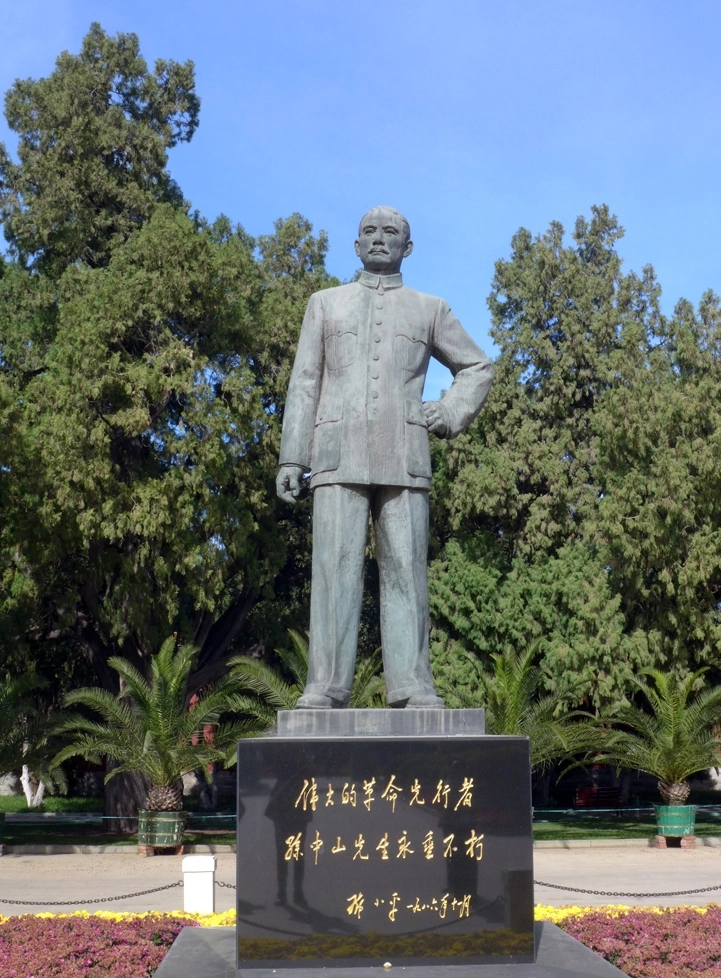
The statue is 3.4 meters high and weighs 1.8 tons. The base is 1.6 meters high and is covered with black marble. Inscribed on the front is a gilded inscription by Comrade Deng Xiaoping, “Mr. Sun Yat-sen, the forerunner of the great revolution, is immortal”. The statue was proposed in March 1983 by 54 members of the Beijing Municipal Committee of the Chinese People’ s Political Consultative Conference (CPPCC) to commemorate the 60th anniversary of Mr. Sun Yat-sen’s death. Approved by the Beijing Municipal Committee, in early 1985, the Beijing Sculpture Art Committee decided to recommend Zeng Zhuyun, the municipal CPPCC member, professor of China Central Academy of Fine Arts to preside over the design, and the Beijing Mechanical and Electrical Research Institute to cast.
Garden of Fragrant Flowers
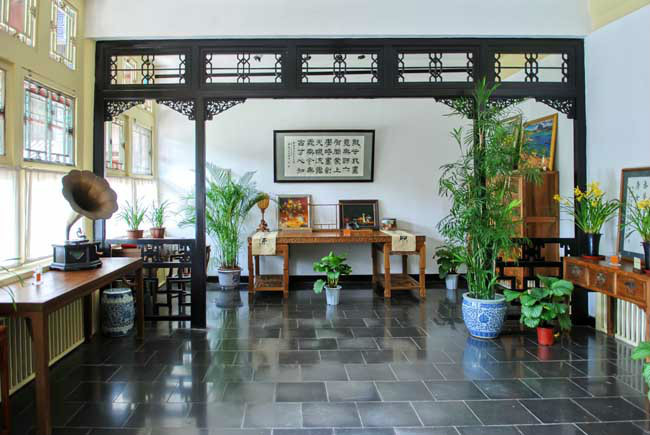
Located in the northwest corner of the inner altar, the Garden of Fragrant Flowers’ original site is the flower-growing greenhouse, which aims to promote Chinese orchid culture. Construction of the garden began in 1988 and it was opened to the public in September 1990, covering an area of 7,600 square meters and a structure area of 986 square meters. The garden not only reflects the national characteristics of the Chinese garden landscape, but also highlights the characteristics of orchids. It is designed in an enclosed way, with bamboo and pine hedgerow to separate the space, through the transformation of terrain and density of plants, creating a quiet and elegant natural landscape.
Changqing Garden
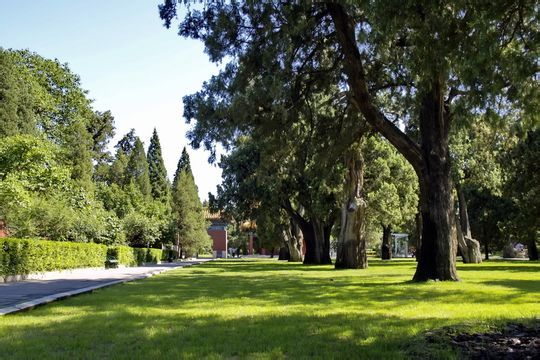
Changqing Garden is located at the north end of Huantan East Road, covering an area of 3,300 square meters. At the north end of the garden are six tall spruce trees that were used on both sides of the podium at the 1976 memorial service for Chairman Mao Zedong. East of the spruce trees are rocks, next to the bamboo forest. Several steps from south building is a flower stand made by bamboo, surrounded by benches for visitors to rest. There is one group of big bonsai on the south side of the flower stand and one Pinus Tabulaeformis inside it. There is a popularization science gallery and a health and epidemic prevention bulletin board for visitors to read.
Maxim Pavilion
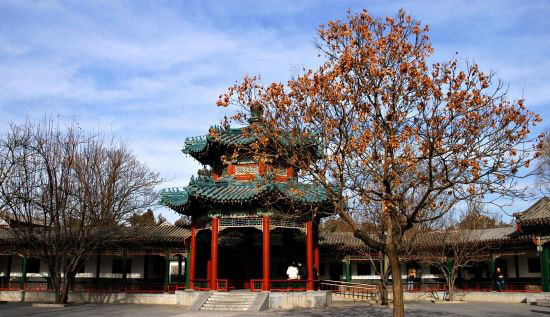
The Maxim Pavilion is located outside Beitanmen, which is made of white stones with a diameter of 6.6 meters and a height of about 8 meters and is surrounded by railings. Railings are divided into 4 groups with 12 ball-shaped stone piers, each group of 3, in the middle with an iron pipe connected, and there are exits around. On the inside of each of the eight pillars is an ancient maxim. The moral of these maxims mostly for curing patients, so that it is also known as Yaoyan Pavilion or Yaoshi Pavilion. The pavilion was donated to build in 1915 by Yongtao, who was Zhu Qiqian’s friend and the consultant of president at the time, which was for admonishing people and adding landscape. It was the only western-style pavilion in the park.
Xi Li Pavilion
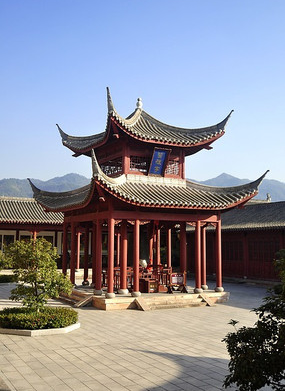
Xi Li Pavilion is located on the south side of Nantanmen, with a yellow glazed tile top and hexagonal shape, built on a two-tier platform foundation, having stone steps on both north and south sides. The upper platform foundation is made of stone, 0.65 meters high and 22.32 meters long. The bottom platform foundation is made of bricks, 0.63 meters high and 35.76 meters long. The pavilion was built in the 18th year of the Ming Dynasty (1420). It was specially designed for civil and military officials, leaders of ethnic minorities and tributary envoys who came to the capital for the first time to practice the rituals of paying a formal visit to the emperor during the Ming and Qing Dynasties (1368-1912), so that it is also called Yan Li Pavilion.
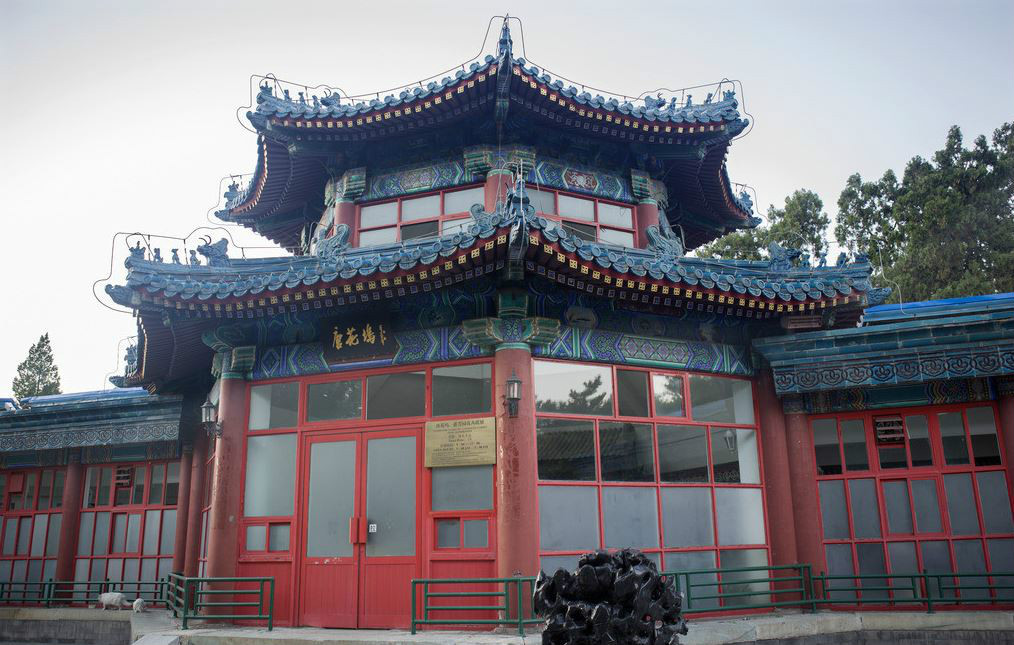
Tanghuawu was built in 1915, and it was made of brick and wood at the time, with 14 houses and the overall form of flying swallow wings. In 1936 and 1964, this greenhouse was renovated several times. In 1970, because of the key project in the park, the rocks in front of it were removed. In May 1992, it was fully restored. The renovated greenhouse has retained the original flying swallow wing-shape, and the double wing’s roof is raised to facilitate daylighting, and the gross leasable area is 417.5 square meters.
The whole building is created with Chinese classical architectural style, which is decorated with red pillars, red doors and windows, and between the top and the middle of the roof inlaid with stained glass. It is a place for perennial flower exhibitions in the park. Over the years, the park has adopted advanced technology to make peonies, plum blossoms and winter jasmine flowers bloom at the same time in December, which has become an excellent scene of flowers in the capital.
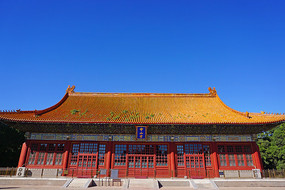
Zhongshan Hall, located in the north of the altar, is an important building on the axle wire of the Altar of Land and Grain. This hall is made of yellow glazed tile roof and decorated with colorful paintings of a golden dragon. The platform foundation is 0.87 meters high and the coverage area is 950.4 square meters. It is said that before the Ming Dynasty, there was no worship hall on the Altar of Land and Grain, then Zhu Yuanzhang, the first emperor of the Ming Dynasty, felt that it was beneath the dignity of the emperor, so he ordered to build the worship hall.
After the founding of the People’s Republic of China, it has held the people’s congresses of all sectors for four sessions. Now, on March 12 and November 12 each year, people from all walks of life in the capital will gather here to celebrate the anniversary of Mr. Sun Yat-sen’s birthday and death.
South gate -> Peace Defendant Arch -> Statue of Mr. Sun Yat-sen -> Xili Pavilion -> Lantingbei Pavilion -> Zaisheng Pavilion -> Garden of Fragrant Flowers -> the Altar of Land and Grain -> Zhongshan Hall -> Maxim Pavilion -> East gate
Take bus No. 1, 5, or 52 and get off at Tian’anmen West Station, walk east along the north side of the road for 3 minutes to reach the south gate of the park.
Take bus No. 5 and get off at Zhongshan Park West Gate station, walk north along the east side of the road for 3 minutes to reach the west gate of the park.
By Subway
Take subway line 1 and get off at Tian’anmen West Station, exit B. Walk east along the north side of the road for 3 minutes to reach the south gate of the park.
By Taxi
Chinese: 请带我去中山公园。English: Please take me to Zhongshan Park.
If you go to Zhongshan Park from the center of Beijing (Grand Hyatt Beijing), it takes about 10 minutes (about 15 yuan).
If you go to Zhongshan Park from Beijing Capital International Airport, it takes about 35 minutes (about 100 yuan).
If you go to Zhongshan Park from Beijing Daxing International Airport, it takes about 75 minutes (about 170 yuan).
If you go to Zhongshan Park from Beijing West Railway Station, it takes about 25 minutes (about 30 yuan).
